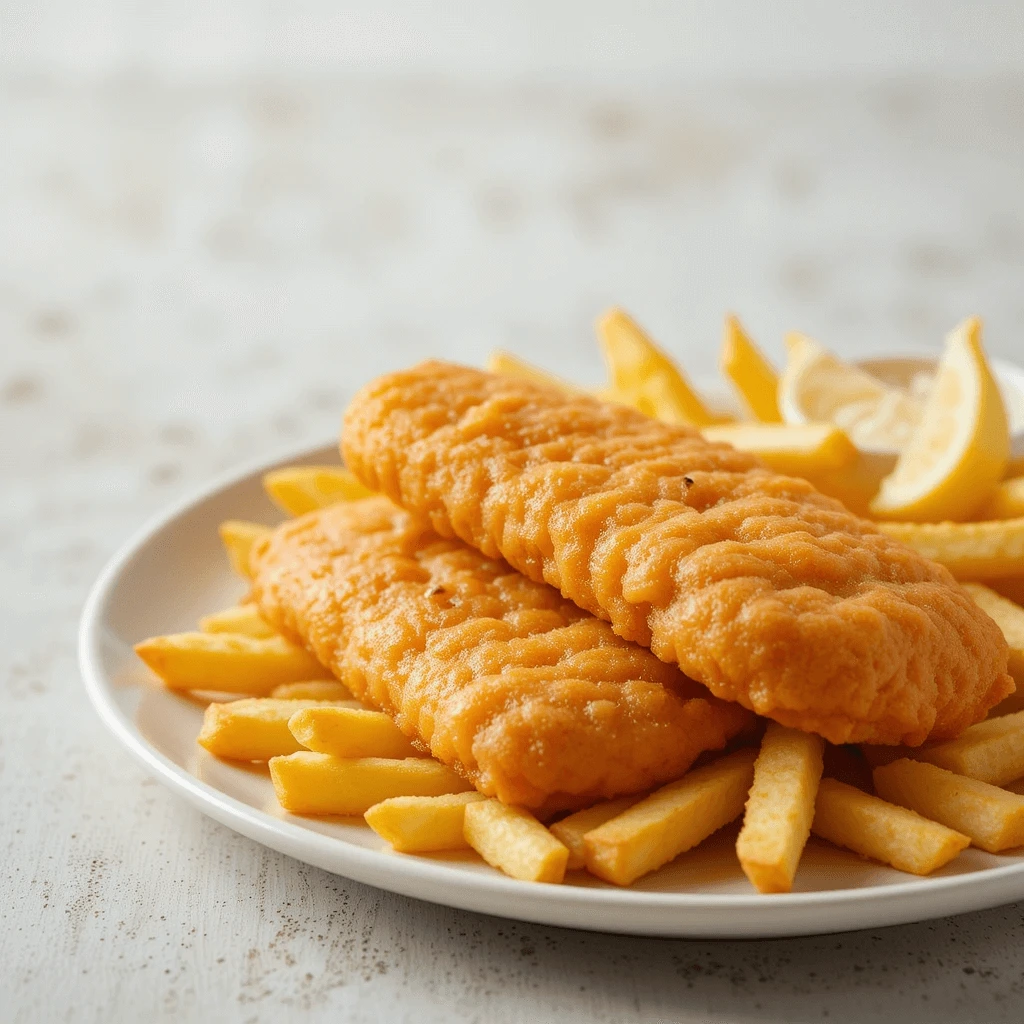Introduction
Fish & Chips is one of the most iconic comfort foods in the world, loved across countries and cultures. From its humble origins in the United Kingdom to its global adaptations, this dish has stood the test of time. While it’s most commonly associated with the UK, variations of Fish & Chips can be found all over the world, each bringing its own spin to this dish. In this article, we will explore the rich history of Fish & Chips, its different versions around the world, cooking techniques, and health implications. Along the way, we will also share tips on how to make the best Fish & Chips at home and highlight some commonly asked questions about this delicious dish.
Print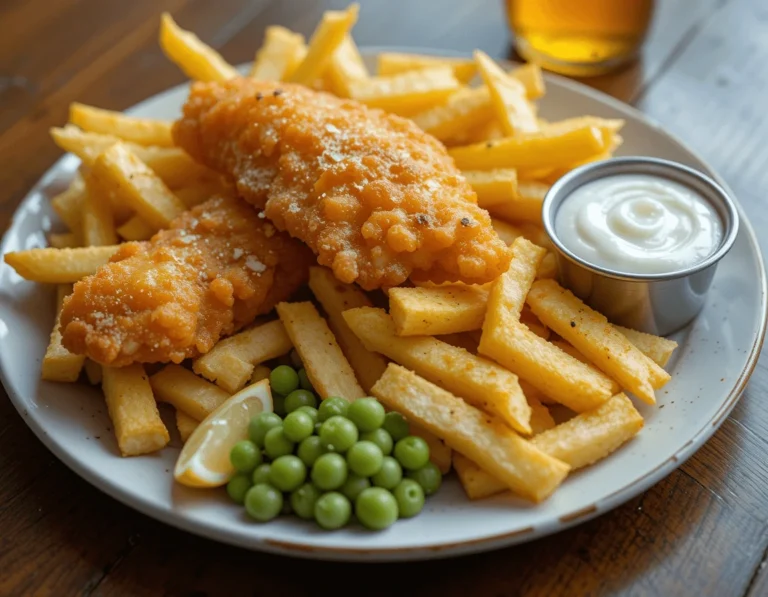
Fish & Chips: The Classic Dish with Global Variations
A delicious and classic British dish, Fish & Chips features golden-battered fish fillets served with crispy fries. This dish is a comforting, crispy meal loved around the world, and it’s perfect for a quick dinner or a traditional takeaway experience at home.
- Total Time: ‘0 minutes
- Yield: 4 servings 1x
Ingredients
For the Fish:
4 white fish fillets (cod, haddock, or any firm white fish)
1 cup all-purpose flour
1 teaspoon baking powder
1 cup cold water (or cold beer for extra crispiness)
Pinch of salt
Vegetable oil (for frying)
For the Chips:
4 large potatoes (Russet or Maris Piper)
Vegetable oil (for frying)
Salt (for seasoning)
Optional Accompaniments:
Malt vinegar
Tartar sauce
Lemon wedges
Mushy peas
Instructions
Prepare the Potatoes:
Peel the potatoes and cut them into thick fries. Rinse them in cold water to remove excess starch.
Heat vegetable oil in a deep fryer or large pot to 350°F (175°C).
Fry the chips in two stages. First, cook the chips at a lower temperature (around 325°F / 160°C) for 4-5 minutes until softened. Remove and drain on paper towels.
Increase the oil temperature to 375°F (190°C) and fry the chips again for 2-3 minutes until crispy and golden. Drain and season with salt.
Prepare the Fish:
Mix the flour, baking powder, and salt in a bowl. Slowly add the cold water or beer until you achieve a smooth batter.
Heat oil in a frying pan or deep fryer to 350°F (175°C).
Dip the fish fillets into the batter, coating them evenly, and fry them in the hot oil for 5-7 minutes until golden and crispy. Remove and drain on paper towels.
Serve:
Serve the fish and chips hot with malt vinegar, tartar sauce, and lemon wedges. Optionally, add mushy peas for a traditional British touch.
Notes
For extra crunch, refrigerate the battered fish fillets for about 30 minutes before frying.
If you want to make the chips healthier, you can bake them in the oven at 400°F (200°C) for 25-30 minutes, flipping halfway through.
- Prep Time: 20 minutes
- Cook Time: 20 minutes
- Category: Main Dish, Comfort Food
- Method: Frying
- Cuisine: British
Nutrition
- Serving Size: 1 plate (with 1 fillet of fish and a generous serving of chips)
- Calories: 600-800 kcal (depending on the type of fish and amount of oil used)
- Sugar: 2g
- Sodium: 800mg
- Fat: 30g
- Saturated Fat: 5g
- Unsaturated Fat: 20g
- Trans Fat: 0g
- Carbohydrates: 80g
- Fiber: 5g
- Protein: 25g
- Cholesterol: 800mg
Keywords: Fish & Chips, British Fish and Chips, Crispy Fish, Fried Fish, Classic Comfort Food, Fish Fry, Traditional British Recipe
The History of Fish & Chips
Origins of Fish & Chips
Fish & Chips is widely considered a traditional British meal, but its origins trace back to Jewish immigrants in the United Kingdom. The dish likely originated in the 19th century, with fried fish being brought to the British Isles by Sephardic Jewish immigrants from Portugal and Spain. The idea of pairing fried fish with fried potatoes was an invention of working-class Brits, who were looking for affordable, satisfying meals.
How Fish & Chips Became Popular in the UK
Fish & Chips quickly became a staple of the British working-class diet. The first fish and chip shop is believed to have opened in London in 1860, and the dish became so popular that by the early 20th century, there were thousands of Fish & Chips shops across the UK. During World War II, Fish & Chips remained one of the few foods that were not rationed, making it even more entrenched in British culture.
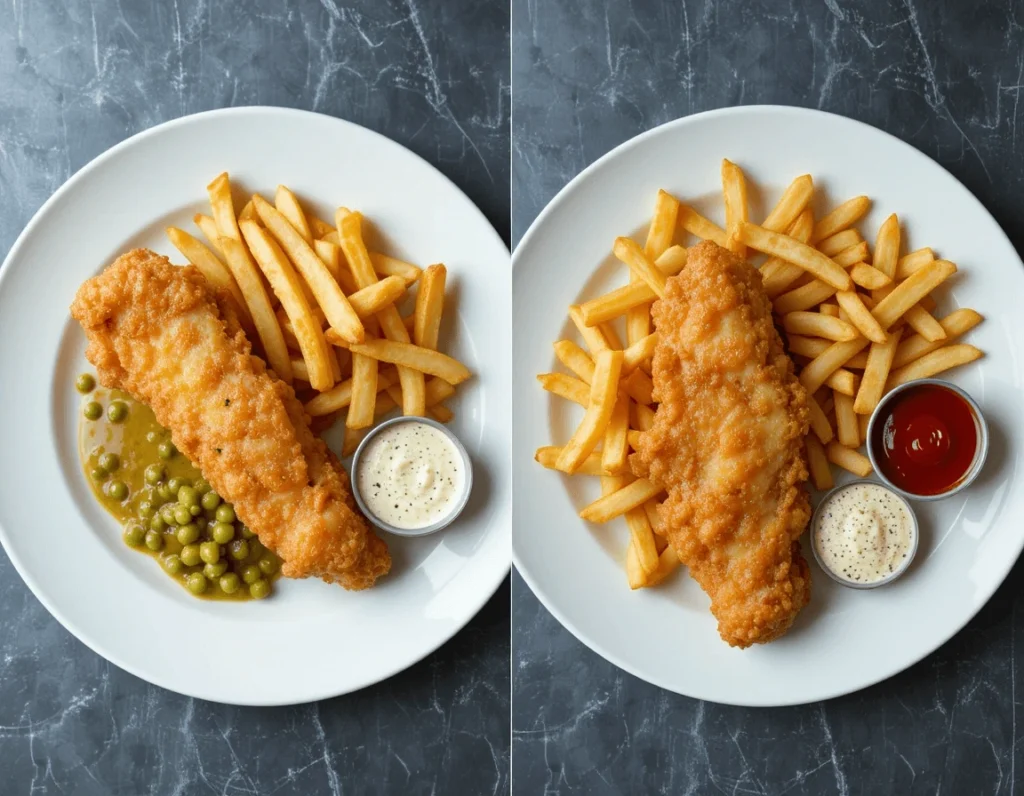
Table of Contents
Table of Contents
The British and American Approach to Fish & Chips
What Do Americans Call Fish and Chips?
In the United States, Fish & Chips is typically called “fish and fries,” though the original term “Fish & Chips” is also understood, especially in places with a significant British or Irish population. However, the American version of “fish and fries” often lacks the same crispy batter and comes with a wider variety of fish.
How Do British People Say Fish and Chips?
In the UK, “Fish & Chips” is the traditional and universally understood term. Regional variations exist, however. For example, in Scotland, the dish is sometimes called a “fish supper,” referring to the fact that Fish & Chips is often consumed as an evening meal. Despite these minor variations, the classic term “Fish & Chips” remains the most widely used.
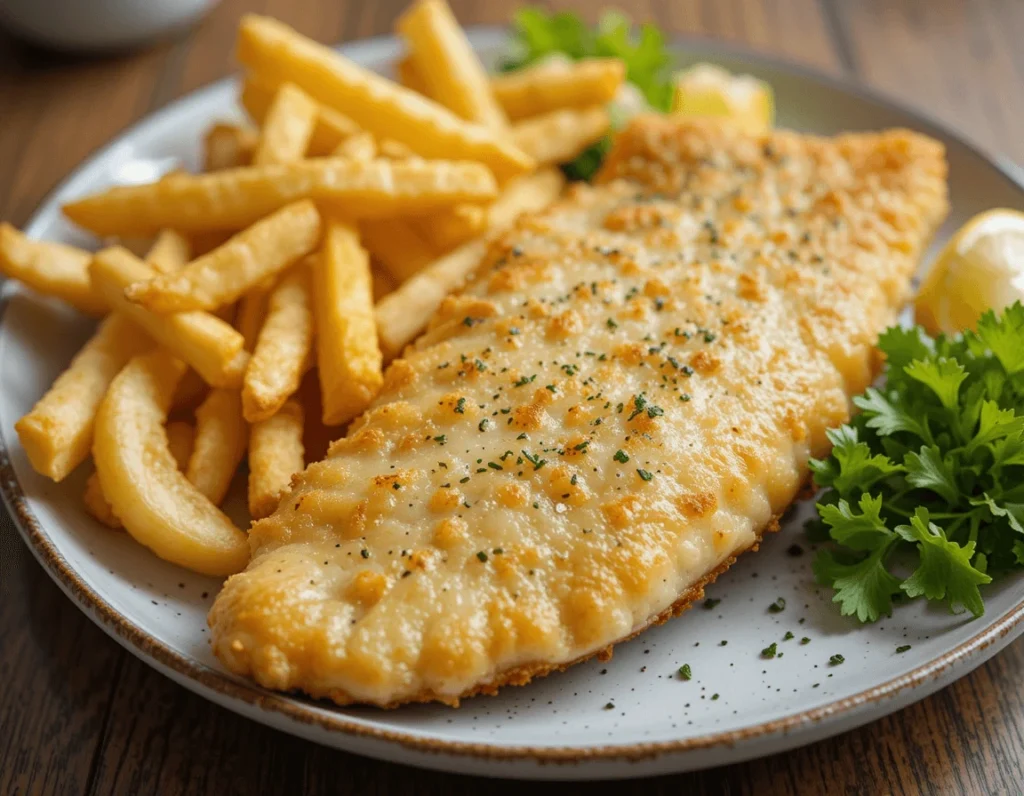
Health Aspects of Fish & Chips
Is Fish & Chips an Unhealthy Meal?
Traditionally, Fish & Chips are considered an indulgent and high-calorie meal due to the deep-frying process. The fish is often battered and fried, and the chips (or fries) are fried in oil. This makes the dish high in fat and calories. However, this does not necessarily make Fish & Chips inherently unhealthy. When prepared using healthier oils or oven-baking techniques, the dish can be a more nutritious option.
Can Fish & Chips Be Made Healthier?
Yes, you can make Fish & Chips healthier by:
- Using leaner fish like cod, haddock, or pollock.
- Opting for whole wheat batter for a bit of extra fiber.
- Air-frying or oven-baking the fish and chips instead of deep frying.
- Using a healthier oil, like olive oil or avocado oil, for frying.
Fish & Chips Around the World
Australian Fish & Chips: What Makes Them Unique?
While Fish & Chips is a favorite meal in Australia, the country adds its own unique twist to the dish. Australians often use different types of fish, such as whiting or flathead, which are common in Australian waters. The batter is typically a little lighter than the traditional British version, and the chips are often crispier.
The English Version: A Traditional British Take
In England, Fish & Chips is a well-established tradition. The dish is often served with mushy peas, a side of tartar sauce, and, of course, vinegar. In the UK, it’s not just about the taste but also the experience of having Fish & Chips wrapped in paper, a tradition that dates back to the origins of the dish.
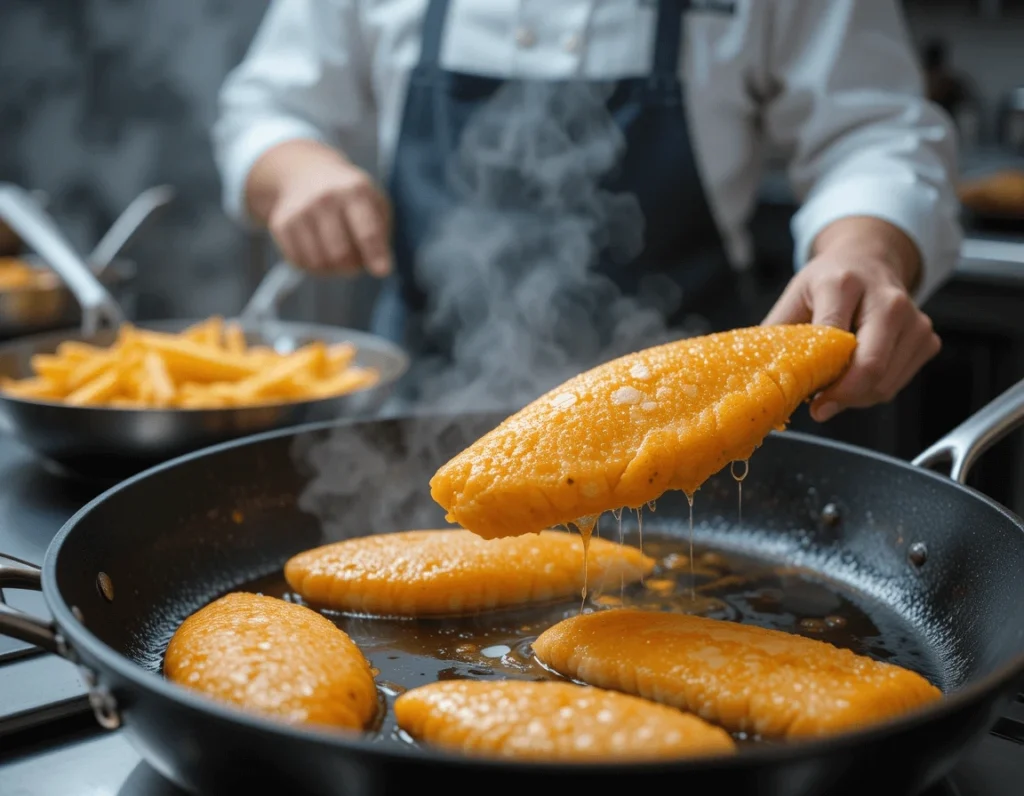
Cooking Techniques for Perfect Fish & Chips
How to Fry the Perfect Fish
Frying the perfect fish for Fish & Chips is an art form that requires attention to detail and some key tips to ensure the fish comes out crispy on the outside and tender on the inside. Here are the steps you can follow to achieve this:
- Choose the Right Fish
The most popular fish for Fish & Chips are cod and haddock due to their mild flavor, flaky texture, and firm consistency. These types of fish hold up well to battering and frying, making them ideal choices for the dish. However, you can also use other firm white fish such as pollock or tilapia. Just make sure to choose fish that won’t fall apart during the frying process. - Prepare the Batter
The batter is key to getting that golden, crispy exterior. A simple batter can be made using flour, water, and a pinch of salt. Some recipes add a bit of baking powder to help create a lighter, fluffier batter. Cold water (or even cold beer) is essential for achieving the desired crispiness, as the cold liquid helps the batter to react quickly to the hot oil. You can also experiment with adding spices or seasonings to the batter for extra flavor. - Ensure the Oil is at the Right Temperature
One of the most crucial steps to frying perfect fish is ensuring the oil is at the right temperature, which is around 350°F (175°C). If the oil is too hot, the batter will burn before the fish is cooked through. If the oil is too cool, the fish will absorb too much oil and become greasy. You can use a thermometer to check the oil temperature, or simply drop a small bit of batter into the oil – if it sizzles and floats to the surface quickly, the oil is ready. - Fry in Small Batches
To avoid overcrowding the pan, which can cause the temperature of the oil to drop, fry the fish in small batches. Overcrowding will not only affect the crispiness of the batter but also make it difficult to cook the fish evenly. Frying in batches ensures that the fish cooks thoroughly and crisps up perfectly without becoming soggy or greasy. - Drain the Fish
Once the fish is golden brown and crispy, use a slotted spoon to remove it from the oil and place it on a paper towel-lined plate or rack to drain excess oil. This helps to keep the batter crisp and prevents it from becoming soggy.
By following these tips, you’ll be able to achieve perfectly fried fish with a light, crispy batter that’s golden on the outside and tender on the inside.
The Art of Frying Chips
While the fish takes center stage in Fish & Chips, the chips (or fries) are just as important. Achieving the perfect chip requires the right technique to ensure a crispy exterior and a fluffy interior. Here’s how you can master the art of frying chips:
- Choose the Right Potatoes
The best potatoes for chips are starchy potatoes, such as Russet or Maris Piper. These potatoes have a higher starch content, which helps create a crispier exterior while maintaining a soft, fluffy interior. Avoid waxy potatoes, which are better for boiling, as they don’t fry as well. - Cut the Potatoes to the Right Size
For traditional Fish & Chips, cut your potatoes into thick chunky fries (about 1-inch wide). The thicker cuts allow the chips to cook evenly and provide the desired texture – crispy on the outside, soft and fluffy on the inside. If you prefer thinner fries, feel free to adjust the size, but keep in mind that thinner fries will cook more quickly. - Fry in Two Stages
The key to achieving the perfect chip is frying in two stages:- First Fry – Start by frying the chips at a lower temperature (about 325°F / 160°C) to cook the potatoes through. This will soften the insides without crisping them up too much. Fry the chips for about 4-6 minutes until they’re tender but not yet golden.
- Second Fry – After draining and cooling the chips for a few minutes, increase the oil temperature to 375°F / 190°C for the second fry. This higher temperature will crisp up the exterior of the chips, creating that signature golden, crunchy texture. Fry the chips for another 2-4 minutes until they are golden brown and crispy.
- Season Immediately After Frying
After frying, it’s essential to season the chips immediately while they are still hot. This allows the seasoning to stick to the crispy surface. Salt is the most common seasoning, but you can experiment with other options like vinegar, paprika, or garlic powder to add extra flavor. Traditional Fish & Chips is often served with malt vinegar, which adds a tangy contrast to the rich fried flavors. - Drain and Serve
As with the fish, once the chips are crispy and golden, remove them from the oil and place them on a paper towel-lined plate to drain off excess oil. Serve them immediately to ensure they stay crisp and hot.
By mastering these techniques, you’ll be able to create the perfect Fish & Chips with crispy, golden fries that complement the fried fish beautifully.
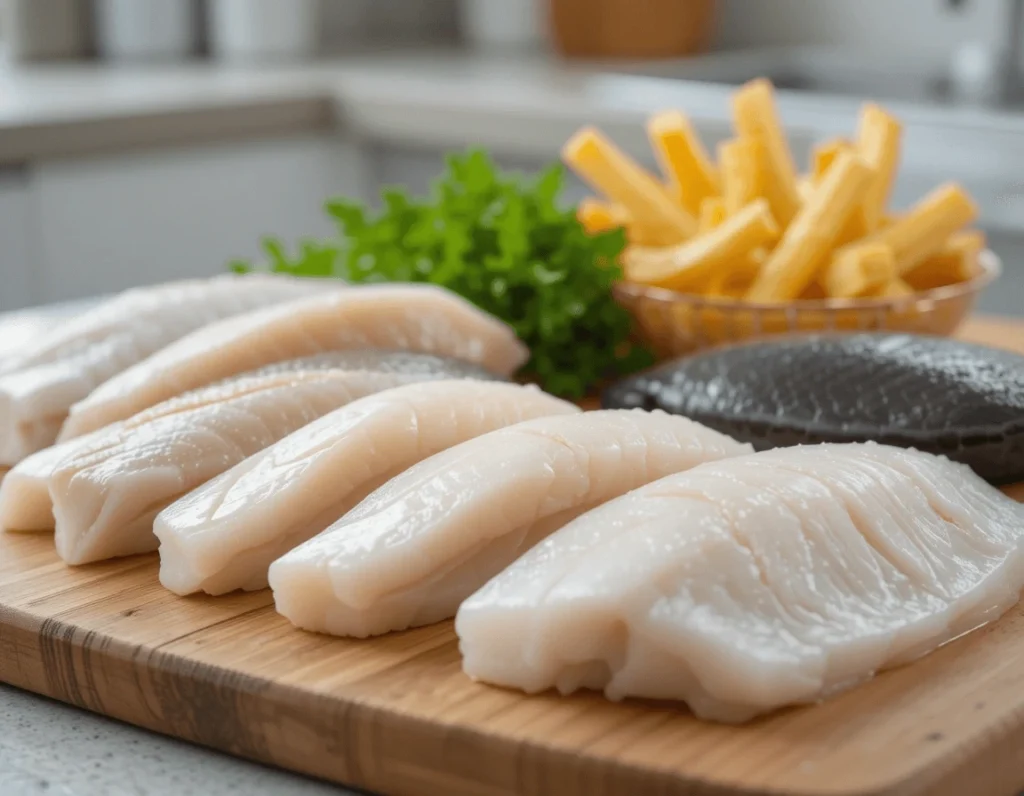
The Best Fish for Fish & Chips
Popular Fish Choices for the Dish
| Type of Fish | Characteristics | Best For |
|---|---|---|
| Cod | Flaky, mild flavor, firm texture | Classic Fish & Chips |
| Haddock | Slightly sweeter, tender flesh | Traditional UK version |
| Pollock | Mild flavor, slightly softer texture | Common in the US and fast food chains |
| Whiting | Light and delicate, mild taste | Popular in Australia |
| Tilapia | Mild flavor, slightly firmer texture | A leaner, affordable alternative |
This table highlights the different types of fish used in Fish & Chips and their unique characteristics to help you choose the best one for your recipe.
Sustainability in Choosing Fish
With overfishing being a global issue, it’s important to choose sustainable seafood for your Fish & Chips. Look for fish certified by organizations like the Marine Stewardship Council (MSC) or opt for local, sustainably caught fish to help support the environment.
Accompaniments and Sauces for Fish & Chips
Classic Sauces: Vinegar, Tartare, and More
Fish & Chips is often paired with a variety of sauces to enhance its flavor:
- Malt vinegar is the most traditional condiment, offering a tangy, sharp contrast to the fried fish.
- Tartar sauce is a creamy, tangy sauce made with mayonnaise, pickles, and capers.
- Ketchup is also a popular alternative, especially in the US.
Side Dishes and Extra Toppings
Beyond the fish and chips, some common side dishes and toppings include:
- Mushy peas: A British favorite that adds a soft, creamy element to the meal.
- Coleslaw: A crunchy, tangy accompaniment often served in the United States.
- Pickled onions: Another British favorite that pairs well with the deep-fried flavors.
| Sauce/Condiment | Description | Best Paired With |
|---|---|---|
| Malt Vinegar | Sharp, tangy vinegar that enhances the flavor of the fish | Classic Fish & Chips (UK) |
| Tartar Sauce | A creamy sauce made with mayonnaise, pickles, and capers | Great for battered fish |
| Ketchup | Sweet and tangy, commonly used in the US | Popular in America and for fries |
| Mushy Peas | A classic British side, made from peas mashed with butter | Traditional British Fish & Chips |
This table provides a breakdown of classic sauces and condiments served with Fish & Chips, showcasing the flavors they complement.
The Cultural Impact of Fish & Chips
Fish & Chips as Comfort Food
Fish & Chips holds a special place in the hearts of many people worldwide as the ultimate comfort food. It’s more than just a meal; it’s a dish that carries with it memories of warmth, comfort, and satisfaction. In many cultures, Fish & Chips is the go-to meal for a quick, fulfilling bite, especially on cold, rainy days or after a long workweek. Its combination of crispy, golden fish and hearty, perfectly fried chips provides an instant sense of comfort and familiarity.
In the United Kingdom, Fish & Chips has long been associated with a Friday night tradition. This “chippy tea” or “fish supper” is a ritual for many British families, a break from the normal cooking routine, offering a chance to unwind and enjoy a beloved meal. Similarly, in Australia, Fish & Chips is a quintessential takeaway dish, often enjoyed by families after a busy day or on weekends at the beach. Whether it’s shared with loved ones at a seaside picnic or enjoyed while watching a sporting event, Fish & Chips evokes a sense of nostalgia and brings back memories of simpler times, making it an enduring comfort food for all ages.
The simplicity and ease of preparation make it accessible to everyone, from home cooks to street vendors. Despite its humble origins, Fish & Chips brings joy and satisfaction to millions around the globe, making it an iconic comfort food that is both familiar and timeless.
The Role of Fish & Chips in Social Gatherings
Beyond being a comforting meal, Fish & Chips plays a significant role in bringing people together. It is a communal dish, often shared among friends and family, and a central feature in social gatherings across cultures. Whether it’s enjoyed in a casual pub setting with a pint of beer or wrapped in paper at the seaside, the dish has a unique ability to foster a sense of togetherness. There’s something special about sitting down with loved ones and sharing a portion of Fish & Chips, all the while creating memories and savoring the simple pleasures of life.
In the UK, many families and groups of friends make a ritual out of visiting the local fish and chip shop. It’s a social event as much as a culinary one, where people chat about their day, laugh, and bond over a plate of crispy fish and chips. In seaside towns, it’s a common sight to see people eating Fish & Chips wrapped in paper by the beach, enjoying the ocean breeze and each other’s company. This tradition underscores how food can unite people and create lasting memories.
Fish & Chips also plays a key role in festivals, street food markets, and other public events. It’s not just about the food – it’s about sharing an experience with others. From outdoor markets in the UK to food festivals in Australia, Fish & Chips is often the dish that brings people together, creating a sense of community around the shared enjoyment of a beloved meal.
In many ways, Fish & Chips is more than just a meal – it’s a symbol of the simple joys of life, a dish that transcends borders and cultures, and a central part of social life. It reminds us that sometimes, the best moments are those spent with loved ones, sharing good food and good company.
Frequently Asked Questions About Fish & Fries
What Do Americans Call Fish & Fries?
Americans often call this dish “fish and fries” but may still refer to it as “Fish & Chips” in certain regions or contexts
How Do British People Say Fish & Fries?
In the UK, “Fish & Chips” is the standard term, though it may be called a “fish supper” in Scotland.
Is Fish & Fries an Unhealthy Meal?
Traditional Fish & Fries can be unhealthy due to the deep-frying process, but there are ways to make it healthier by using lean fish, lighter batter, and healthier cooking methods.
What Is the Difference Between Australian and English Fish & Fries?
The main difference lies in the types of fish used and the batter style, with Australians often using lighter batter and different fish varieties, while the British version uses cod or haddock with a thicker batter.
Conclusion
Fish and Fries is more than just a meal; it’s a cultural icon that has spanned across continents, evolving in many different ways. This humble dish has become an enduring symbol of comfort food, evoking a sense of nostalgia, warmth, and simplicity for millions of people worldwide. From the traditional British version served with malt vinegar and mushy peas to the lighter, crispier Australian style served with a variety of fish, Fish & Fries has taken on unique forms wherever it has traveled, yet its essence remains the same – a satisfying and delicious combination of fried fish and crispy fries.
What makes Fish & Fries so special is not just its taste, but also the rich history and cultural significance behind it. From its origins in the United Kingdom to its global variations, this dish has become a symbol of togetherness, often enjoyed with family or friends at pubs, seaside resorts, or takeaway spots. Whether you’re having it for a quick weekday dinner or as a treat on a sunny afternoon, Fish & Fries offers an experience that goes beyond the food itself.
For those who wish to recreate this iconic meal at home, we’ve provided tips on how to fry the perfect fish, achieve the crispiest fries, and choose the best fish for the dish. You can experiment with different variations, from using healthier cooking methods to trying new accompaniments or sauces. The beauty of Fish & Fries lies in its versatility and the endless possibilities for customization.
Now, with all the information and tips provided in this article, you can bring a taste of this beloved dish into your own kitchen. Whether you’re enjoying the British classic or adding your personal twist, the world’s love for Fish & Fries will continue to be celebrated, one crispy bite at a time. So go ahead, indulge in this timeless dish, and experience its global charm – right at home.
How to Make Perfect Fried Fish
The Best Sides for Fish & Chips

